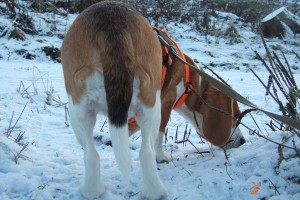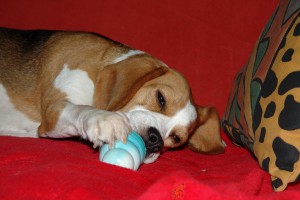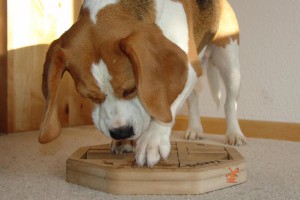
After 9/11, I was tasked to rebuild a FEMA disaster search dog
program in need of reworking. To begin I recruited 15 dog handlers of
whom more than 50% were police and firefighters so that we got an
emergency response culture. Then I bought young adult Labrador
Retrievers and placed one with each handler. The dog lived with, and was
trained by his handler. I trained the handlers to train the dogs. I had
them 2 to 3 sessions per week for 2 ro 3 hours.
I started off with traditional compulsion training which was all that
I knew at that time. After about 3 months I looked at our progress
records and determined that at the rate we were going, it was going to
take 18 months to get the team operational. In the world of emergency
operations that is way too long. I had to find a faster training model. I
looked around for a leading edge animal training program and found the
US Navy’s Marine Mammal Training program. They were training dolphins to
detect tethered anti-submarine mines several hundred feet beneath the
ocean’s surface. The dolphins also had to conduct their searches through
and around schools of fish. Since fish is their natural diet and also
serves as the dolphins’ training rewards, the behavior being trained was
very difficult. They are trained entirely with B.F. Skinners operant
conditioning with positive reinforcement. I picked it for my search
team.
The dog adaptation of B.F. Skinner’s positive training model is
popularly termed clicker training. I adopted it and started training
dogs and handlers to the new model. I loaded all the handlers on an
airplane and we attended a national three-day clicker training seminar
consisting of presentations from world class experts. I also followed up
by bringing in two of these experts to conduct individual coaching with
the handlers. The end result was the drastic reduction of the
dog/handler training time. It went from 18 months to 6 months, a 300%
reduction. That told me the positive training model is 3 times easier
for novice trainers to master.
I have spent the past 10 years developing a training model that
adapts the B.F. Skinner positive training model to retriever gundogs,
and I have a come up with a very simple, workable model. I have used it
on over 100 gundogs dogs very successfully, and have been teaching it to
novice trainers with great success.
For a high probability of success with the training model there are two prerequisites:
(1) Fluency at coming when called – The dog should come on one cue (or
command) consistently from 30 yards, even in the presence of moderate
distraction. A good place to check this out is to train the distraction
part in a dog park where there are plenty of other dogs. When your dog
comes consistently on cue from thirty yards when there are other dogs
running around, then he is fluent at recall in a moderate distraction
environment.
(2) Fluency at Delivery to hand – the dog should consistently deliver to hand.
Deficiencies in these two behaviors usually stem back to punishment
that was unknowingly or inadvertently or accidentally delivered. Neither
the how nor the why is relevant. The quickest fix is to give the dog
lots of payments (highly desirable treats) for coming to you. If
delivery to hand is a weakness, make sure you give the payment when the
dog is all the way to you; his nose is within an inch or so of your leg.
Here is the training model:
1. Dummies before birds – Train the dog with dummies. Canvas is
better. Canvas dummies are comfortable for the dog to carry and promote
delivery to hand. When the behaviors are well established and fluent
with dummies in the face of distraction, then you can work the dog on
birds and have a low probability of encountering problems. Birds are
simply a fairly high distraction level. Save them until the behaviors
are fluent in moderate to high distraction levels. Then working with
birds will not create problems.
2. Blinds before marks – A blind retrieve is the retrieve of
a bird which the dog has not seen fall. Marked retrieves are of birds
that the dog has seen fall. The dog’s ancestors possessed an innate
ability to go catch and eat a bird he saw land in a distant field. If he
did not have this innate talent, then he died. Dog’s need very little
training on this inherited marking behavior. However, because they
trigger such a powerful primary instinct, marked redtrieves are very
disruptive to the training of the gundog’s self-control, impulse control
and manners. Marked retrieves are like crack cocaine. If the dog has
not found out how intoxicating marks are, then whistle stops and hand
signals are much more easily trained, and the dog will like these
control behaviors much more. Do not wake the sleeping monster of marked
retrieves until the dog already fluent on blind retrieves.
3. Steadiness is primary – A gundog’s primary job is to enhance his
owner’s outdoor experience. That means he must be obedient and steady
and calm when 100 ducks are working, duck calls are blaring and 6
shooters are shooting. During such periods of extreme excitement the
gundog should be sitting calmly waiting for instructions. A blind filled
with excited hunters and loaded guns is not the place for an
over-excited, on-the-edge-of-out-of-control gundog.
The trick here is to let the dog learn from puppyhood that calmness pays (with a retrieve).
The dog should get no marked retrieves without a wait of at least
three minutes as this is the average dissipation time of the
neurochemicals that produce the excited emotional state. Sending the dog
when he is calm applies the payment of the retrieve to the emotional
account of calmness. To further promote calmness and steadiness, pick up
most of the seen falls in training yourself.
4. Long unseen cripple – This is the gundog’s conservation function.
This is blind retrieves and hand signals. When there are 4 dead ducks
down out front of the blind with a wing-tiipped cripple down 125 yards
off to the left, the dog needs to go get the cripple first, before that
bird has a chance to swim off and escape, only to die later. This is the
gundog’s most important job. This behavior is easily trained as a chain
ending in a retrieve reward. Breaking it down to its three elements and
training them looks like this:
a. Go out without the lure of a fall:
This is the easiest part of the exercise. Simply take the dog with you
to place the dummy. He has an innate propensity to go back to the place
you left it. After placing the dummy, walk with the dog 10 or 15 yards
back whence you came. Turn and send him for the dummy. Then lengthen to
30 yards. He should be going 30 yards with alacrity and confidence
within 3 to 5 training sessions. Mark the locations that you are sending
the dog from and the location of the dummy for these memory retrieves
so that you can accurately use the same setup for a number of upcoming
sessions. Then you can progress to whistle stopping.
b. Stop/look on whistle:
Note that sitting is not mentioned in the behavior description. Sitting
is not necessary for a dog to accomplish blind retrieves. In fact
sitting leads frequently to complicating the exercise. When the whistle
blows, the dog stops and looks, and the trainer gets in a fight with the
dog about sitting. To the dog, the fight is a punishment for stopping.
Note also that a dog’s ears are 4 times more sensitive than a person. A
dog can hear at 100 yards a sound that you can barely hear at 25 yards.
Keep the whistle volume very low when the dog is close to you and when
he is inside 40 yards or so. Then you will accustom him to respond to
the volume he will hear when he is at 300 yards and you are blowing
loudly.
The whistle stop/look is very quick and easy to train, and a tennis
ball is an excellent reward with which to pay the dog. To most
retrievers a tennis ball is higher in value than a dummy. Take a tennis
ball and make a ¼ in hole through it with a drill. Take a piece of wire 8
inches long, bend in middle to a V shape. Lay a short length of 3/8
rope across the V. Poke the two ends of the wire thru the ball and pull
the rope thru. Put a knot at each end of the rope so that a 6” to 8”
“tail” extends from the tennis ball. This tail gives you great leverage
for longer distance throws. Practice the throwing to insure that your
motor skills are up to the task of making a well timed 30 yard throw,
before you use it with the dog.
Simply take a walk with pup off leash, encourage him to get ahead of you.
When he gets 10 to 20 feet away from you, watch his eyes carefully and
toot the whistle. When he looks at you pay the look with a throw. Then
go for 30 or 40 feet. Your payment throws should soar well past the dog
so that they pull him away from you. Your objective is to pay stop/look
about 5 or 6 times and have the dog responding out to 30 yards. Be
careful not to overdo the payments or you will create a popping (looking
to you without a whistle toot) behavior. Too many short payment throws
can also contribute to a spinning behavior.
One or two sessions should be enough to have pup stopping and giving a
crisp turn to look at you upon a whistle toot. Then you will have the
tools to complete the long unseen cripple exercise. After that it is a
matter of maintaining a balance of payments. When pup is not stopping
well, he needs a payment or two. If he starts spinning or popping he
needs a reduction of payments and a lengthening of the payment throw..
c. Take a Directional Cast
Respond to directional cast by Leaving area of marked fall and take cast
toward the long unseen fall to move the dog’s hunt over to the
appropriate hunting area.
Here is where you put it all together. Take pup and place the long
unseen. Then with pup, walk back 30 yards. Sit pup and walk out 15 yards
on an azimuth at least 30 degrees off of the line to the placed unseen.
Stop and sequentially throw two dummies with good loft and distance so
that pup is quite interested in them. (If pup is sitting on a place
board back at the starting point then it is easier for him to stay).
Pick up the two throws. This makes it very difficult for pup to botch
this exercise. Go back to pup and send him toward the marked falls that
have been picked up.
When he gets to the area of fall, give whistle toot. When the dog
looks, walk the direction that you want him to go. You may have to give
that whistle toot several times and the walking cue several times to get
him to the placed unseen dummy. It may be pretty ragged the first
couple renditions, but that is ok. We are letting pup learn that he gets
paid better when he hunts where you want him to after a whistle stop
and cast. It generally takes a few sessions for pup to get it.
Over a few lessons you should also fade the walking cue from 4 or 5
steps to one step with a hand signal, and then a half step with a hand
signal. The casts are right, left and back. A back cast should be given
with your hand extended straight up high to make it easy for the dog to
distinguish from the right and left casts.
When the dog has mastered the three element behavior chain he can be
pronounced proficient on the exercise of the long unseen cripple. Then
add distractions. For example, add shots on the thrown marks that you
will pick up…..add a kid bouncing a basket ball…..add a guy tossing a
dummy for another dog….. etc. The key is to add distractions at low
level and gradually increase. For example, start the kid with bouncing
basket ball at a distance of 50 yards and move him closer gradually as
fast as your dog’s performance will allow. Distance is great for damping
level of most distractions. Start the distraction at a long distance
and gradually move it closer at a rate governed by the student dog’s
success.
When the dog is proficient at a moderate level of distraction then
move your initial setup to a different field and do it again. Always
remember that the trainer’s job is not to test, but to set up the
exercise so that the dog will succeed. Thus the initial run should be
set at a simple enough level that you are confident of pup’s success.
Then start ratcheting up complexity and distraction level at increments
such that the dog continues to succeed. When pup is proficient in the
second location, move again to a third location with initial
simplification and building back up the distraction level.
When you have moved the training setup of the long unseen cripple to 4
or 5 different locations pup should be getting very good. Then you can
try him on simple cold blinds where you have not taken him with you to
plant them. When he is good at that, add back the diversion marks. At
this point you can probably start leaving the diversion marks laying
where they fall and feel confident that you can handle pup away from
them to fetch the long unseen. After pup is proficient on land, take the
exercise to the water.
Your goal is to get the dog proficient in a high distraction
environment in four or five different locations. Then the dog should be
ready for most situations.
To recap this training model, the objective is to not line the blind.
You want a high frequency of occurrence of the behavior chain: Go
out…..stop/look…….take cast……get reward (dummy or bird). You do not want
pup to line the blind
Every time pup lines the blind he is getting paid to not to stop on a
whistle. The higher the frequency of occurrence of lining the blind; the
less prone pup will be to stop on the whistle.
The same principle applies to marked retrieves. There is no whistle stop in the behavior chain of retrieving a seen fall.
The key to getting whistle stopping responsiveness at a distance is
to crank up the distraction level in the 30 yard zone where you have
control of payment delivery. When pup is fluently stopping at the 30
yard distance in a high distraction environment, then he will stop
fluently at a 150 yards in a moderate level distraction environment.
Try this training model on a young dog that has had very few marked
retrieves and you should have him handling on blind retrieves to150
yards in 3 to 5 months of training.
 Lassen
Sie Ihren Hund beim Spaziergang sicherheitshalber an der Leine und
sichern Sie ihn besonders gut. Wählen Sie Spaziergehzeiten und –orte,
die weitgehend knallfrei sind. Vorsicht auch mit offenen Haustüren,
Gartentoren etc.: Auch ein bislang furchtloser Hund könnte sich
plötzlich erschrecken und in Panik fliehen, wenn direkt in seiner Nähe
ein Knaller losgeht.
Lassen
Sie Ihren Hund beim Spaziergang sicherheitshalber an der Leine und
sichern Sie ihn besonders gut. Wählen Sie Spaziergehzeiten und –orte,
die weitgehend knallfrei sind. Vorsicht auch mit offenen Haustüren,
Gartentoren etc.: Auch ein bislang furchtloser Hund könnte sich
plötzlich erschrecken und in Panik fliehen, wenn direkt in seiner Nähe
ein Knaller losgeht. … lassen Sie Ihren Hund natürlich niemals alleine …
… lassen Sie Ihren Hund natürlich niemals alleine … Wenn
Ihr Hund sich gerne zurückziehen möchte, dann geben Sie ihm Zugang zu
seinem Lieblingsort: ob das im Keller, unter dem Bett oder sogar unter
der Bettdecke ist.
Wenn
Ihr Hund sich gerne zurückziehen möchte, dann geben Sie ihm Zugang zu
seinem Lieblingsort: ob das im Keller, unter dem Bett oder sogar unter
der Bettdecke ist.
